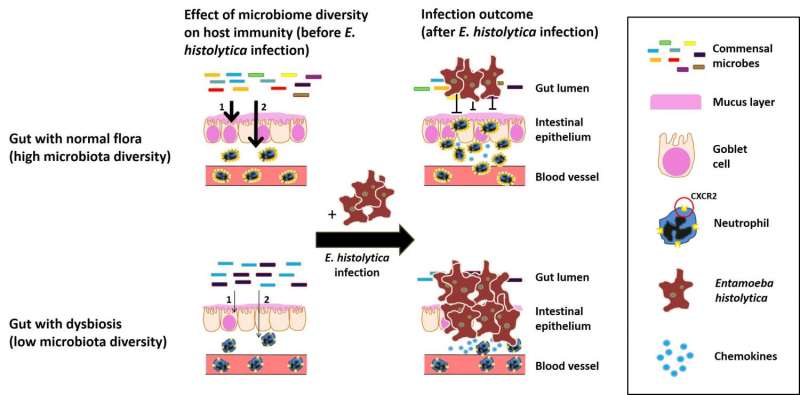Disrupted gut microbiome makes children more susceptible to amoebic dysentery

Children with lower diversity of microbial species in their intestines are more susceptible to severe infection with the Entamoeba histolytica parasite, according to a new study published in PLOS Pathogens.
E. histolytica is an amoeba that typically spreads via food, water, or hands that have been contaminated with feces. Some infected people have no symptoms, but others experience symptoms of varying severity, from mild abdominal symptoms to life-threatening disease. The factors that influence severity are unclear, but previous studies suggest an important role for the gut microbiome.
In the new study, Koji Watanabe of the University of Virginia and colleagues collected and analyzed stool samples from children in an urban slum in Dhaka, Bangladesh. They found that children who experienced colon inflammation because of E. histolytica infection had lower diversity of microbes in their stool than children with asymptomatic infection.
To better understand these findings, the researchers used antibiotics to disrupt the gut microbiome in mice. They then exposed the mice to E. histolytica to see whether they were more susceptible to infection. The researchers found that mice treated with antibiotics had more severe colon inflammation than untreated mice.
Mouse tissue and gene expression analysis showed that disruption of the gut microbiome decreased the activity of infection-fighting white blood cells known as neutrophils. The surface of neutrophils in these mice had lower amounts of a protein known as CXCR2 than in untreated mice. CXCR2 plays a role in the recruitment of neutrophils to fight infection in the gut, so decreased CXCR2 levels likely resulted in the observed decreased neutrophil activity.
The analysis also showed that disruption of the mouse gut microbiome decreased production of a protein known as interleukin-25, which aids the function of the mucosal barrier that acts as the intestine's first line of defense against infection.
These findings suggest a molecular mechanism by which disruption of the gut microbiome increases severity of E. histolytica infection, but further research will be needed to determine if similar molecular effects occur in humans. Meanwhile, the finding that disruption of the mouse gut microbiome can interfere with neutrophil activity may be of broader interest in research of other infectious diseases.
More information: Koji Watanabe et al, Microbiome-mediated neutrophil recruitment via CXCR2 and protection from amebic colitis, PLOS Pathogens (2017). DOI: 10.1371/journal.ppat.1006513



















